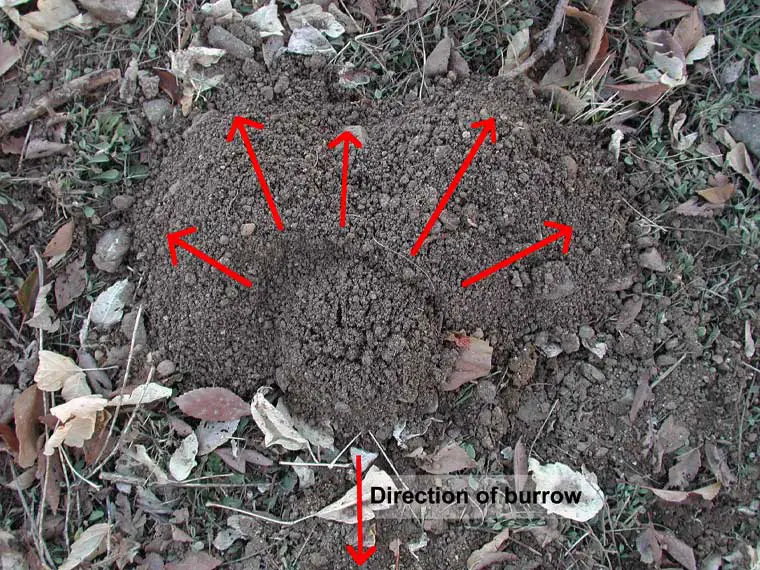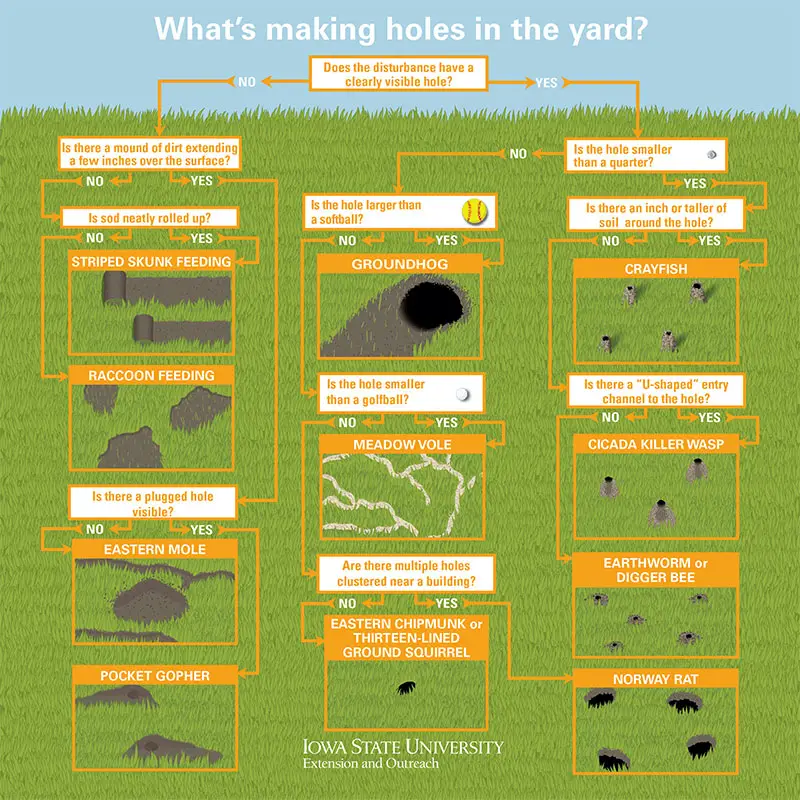Waking up one morning to see a mound of soil on your backyard lawn is enough to raise anxiety levels in any keen gardener. I wouldn’t blame you for being angry, because when you see one gopher hole in a yard, it’s usually the start of many more to come.
Also known as pocket gophers, they are solitary creatures, but can cause a lot of mayhem in yards. Just a single gopher can make one mound per day. Extrapolate that over a month, and that’s means a lot of pocket gopher holes you could be contending with.
In this guide I will explain what gopher holes look like and how you can get rid of them from your yard. Advice on filling the holes is lower down the page, but firstly it’s important to identify what you’re dealing with… it could be a different animal altogether that needs an alternative solution.
What do gopher holes look like?
Gopher holes look like mounds on the surface of your yard lawn. The mounds they leave can be as high as 12 inches, and possibly up to two feet in diameter. They are not small.
The mound will not be circular and neat but instead will have evidence where the gopher has kicked and shovelled the soil out. There won’t be an obvious hole in the mound unless the gopher has vacated the tunnel system or is in and out frequently for food.
If a gopher is in the tunnel, there will be fresh and fluffy soil on the mound which has plugged the hole.
The mound on top of the gopher hole will lead to a main tunnel which can be a few inches to 18 inches underground. The main tunnel will have additional burrows coming, meaning you will start to see more mounds appearing as the gopher builds an extensive home.
If you push the soil away, you will find a hole that is 2½ to 3½ inches in diameter. Some gopher holes can be as deep as 6 feet, but this is unusual, and only happens in yards with extremely soft soil.
Because the tunnels can be quite near the surface of your lawn, they will often collapse, particularly if you walk over and near them.
What’s concerning is how one gopher hole in a yard can lead to 200 yards of tunnels which can cover a 2,000 square foot area.
Gopher hole pictures

Gopher holes vs mole holes
It’s easy to mistake a gopher hole in your yard to a mole hole. But there are some subtle and not so subtle differences.
The first difference you will notice is the size of the mound. Gophers leave larger mounds than moles do. Mole mounds can be around a couple of inches wide, gopher mounds are much bigger, between 10 and 20 inches in diameter.
The way the mound has been constructed will also help you identify what you’re looking at.
When moles dig a hole and push a mound up, it will be conical in shape, often described as being circular like a volcano with a dip or depression in the top. Gopher mounds will have an obvious “splaying out” of the soil where it’s been pushed out of the hole in a singular direction.
Moles are rarely seen by humans. So, if you have mounds, and are seeing no critter, it’s a possible mole. Chances are you will see a gopher at some point.
Gopher hole vs rat hole
Rat holes are very different to those made by a gopher. The most obvious difference is the location, size, and lack of a mound.
- Rats don’t leave large mounds of soil at the entrance to the hole.
- Rat holes have several entrances.
- Rat tunnel entrances are 2 to 4 inches in diameter.
- Rats do not plug or cover the entrances to their holes.
- Rats prefer to burrow along fence lines and walls, and not the middle of lawns.
Handy Hint: You can buy specialist gopher repellent on Amazon. I’ve not used it, but at the price it’s worth it. Find more tips lower down the page.
What damage can gophers do to yards?
The most obvious damage these critters do will be the gopher holes in your lawn, but it can be far more extensive than that. Here’s list of potential problems you might find in your yard.
- Damage to trees: gophers will burrow under root systems, eat roots, and clip down small shrubs to ground level. They can reach about 10 inches high when feeding, so can get up to younger trees / saplings.
- Damage to vegetables: Gophers will eat vegetables and stems you are growing, and eat plants from underneath. They will then die before you notice what’s happening.
- Damage to lawns: One gopher can create up to 30 mounds of soil in just 30 days. Babies born in spring will leave their mother after just a few months to establish their own tunnels.
- Damage to lawn mowers: the mounds can damage the blades on lawn mowers and cause issues for farm equipment.
- Damage to your yard’s irrigation: a failed gopher tunnel could take water away from one area, thus interfering with the irrigation system in your backyard.
- Damage to structural objects: tunnels can stretch underneath paths and buildings. There is a slim chance that the structural integrity of pavements and foundations could be compromised.
- Damage to utility cables and piping: they could also chew through cables or put sewer pipes at risk of collapse. Here’s a video and blog post where gophers have chewed through plastic piping.
One other aspect that’s not often considered is how gophers carry disease. Whilst there are no recorded instances of gophers spreading illness to humans, they could make a pet sick. The Pest Management Division of LA County say:
“Due to the solitary underground nature of pocket gophers, there are no known incidences of diseases spread to humans. Like any rodent, they can be infected with any number of potentially harmful organisms. Any gopher that displays unusual behavior, such being above ground should be avoided and dead gophers should be handled with care. Gophers are very aggressive and can inflict a painful bite if given the chance.”
How to get rid of gopher holes in your yard
Now you know what gopher holes look like, it’s time to take action. There are many ways in which you stop gopher holes in your backyard, but please try to get them to leave their tunnel first and as humanely as possible.
Once they have left their tunnel, you can get rid of the gopher holes. Lower down the page I’ve included 4 methods you can use to fill the tunnels.
Firstly, you need them to leave your yard. Here’s what to put down gopher holes so they evacuate the tunnels before you fill them up. They tend to come out of their burrows during the evening hours, which can be the best time to flush the holes then start filling them.
1. Filling gopher holes with water
Many people will recommend filling gopher holes with water. This will work if you use a hose and send a lot of high pressured water jets into the tunnel.
However, flooding gopher holes does not always work. If you use a lot of water, it can damage your lawn, potentially cause a tunnel collapse, plus make compacted earth softer, so easier for gophers to dig through.
It’s something I only recommend you do for a couple of minutes to avoid any lawn damage. Here’s the process.
- Point a hose down the hole and run it 2 feet down into the tunnel.
- Move back a few yards and turn the water on as powerful as you can.
- Observe the lawn of you yard to see if any gophers pop up and run off.
- Once you see the animals leave the tunnels, you can move to the next section which explains how to fill the tunnels.
- If you don’t see a gopher come out, the burrow is likely uninhabited, but you should still fill it up.
2. Fill pocket gopher holes with dog poop
Gophers are scared of dogs and have a very highly developed sense of smell for potential predators. They usually don’t want to make holes in lawns where dogs regularly defecate. You can take advantage of this fear by pushing dog poop down their tunnels.
It’s not pleasant, but it can be a very effective way to get gophers to leave your yard.
You can also try putting dog urine in gopher holes, although it’s going to be harder to gather enough pee to make this truly effective. However, if you can train or encourage your dog to urinate over the tunnel entrance, it could work very well!
3. Use a sonic vibration deterrent
When a gopher feels a vibration in the earth, it makes them believe that lots of predators are around. They will not want to keep using the holes in your yard if they think they are at risk of being prey… so hopefully will move on.
Amazon sells a device which can vibrate sounds in the earth that you won’t feel or hear, but the gophers in your backyard will. You can read the reviews and check prices on this link or click the image below.
4. Strong tastes and smells such as jalapenos in gopher holes
Next time you cook a spicy meal, you could take advantage of any leftovers you have as gophers are said to be revulsed by strong smells and tastes.
Try tipping the following down the tunnels to see if they pack up and leave.
- Castor oil
- Coffee grounds
- Eucalyptus or menthol oils
- Fishbones
- Hot chilli sauce
- Jalapenos
Some also recommend using washing powder, but I wouldn’t use this as it’s non-organic and could cause damage to the environment and wildlife that you wish to remain in your yard.
5. Set-up traps in your backyard
I recommend humane traps, but this means you then need to take the gopher a few miles away from the home to release it. I understand that many people will struggle to do that. Instead you might consider a more heavy-duty trapping option.
This trap on Amazon can be laid at the entrance to gopher holes in your yard.
6. I do not recommend blowing up gopher holes
I am leaving this one just so you can see the crazy lengths some people have resorted to, by blowing up gopher holes. If you value your lawn, backyard, and possibly even your life, I don’t suggest you try this at home.
In the video they are using a tool called the Rodenator Pro.
7. Remove all temptation from your yard
There will be gopher holes in your lawn because your property attracts them. If you can make your backyard less inviting, they might stop coming back once you have got rid of them.
Sadly, that’s not always going to be possible as they are herbivores. Most yards will be full of things they want to eat… particularly grass.
Gophers eat:
- Acorns
- Grass
- Roots
- Seeds
- Vegetables
- Weeds
If you can keep your yard and lawn clear of seeds, acorns, and protect vegetable patches, it can discourage them returning once you have got rid of them.
8. Have predators as pets
Gophers fear cats and dogs, so having them as pets can help ensure no holes are dug in your lawn. Most dogs will chase gophers, particularly those with a high prey drive.
9. Consider artificial grass
Artificial turf will remove the main food source of gophers (grass), and could reduce the attraction of your backyard. However, gophers can still damage synthetic lawn, so if you do decide to install it, read this first.
10. Lay gopher wire beneath the lawn
When laying new turf after a gopher infestation, you should use gopher wire about 18 inches under the surface. This can stop them from digging up into your lawn.
Gopher wire works a lot better than chicken wire.
How to fix gopher holes in your lawn
If you believe that the gophers are gone, then you can fill and fix the holes without fear of harming them. There are many ways to fix gopher holes in a lawn, most of which involve pouring something down the burrow.
I recommend trying either cement, gravel, or sand, or even a mix. Gophers will struggle to dig through sand and gravel as these materials move the moment they claw some of it away, more shifts into its place – unless it’s wet of course.
Before you start filling the gopher hole, scour your backyard. They might have dug more holes and entrances to their tunnels. Tunnels can be 6 feet deep in places.
Do not pour chemicals or petrol down gopher holes. These methods can be dangerous and ineffective.
1. Filling gopher holes with gravel
Pouring very fine gravel down a gopher hole is one of the most popular methods of filling them. The smaller the gravel, the harder it is for a gopher to dig it out as they prefer to dig holes in firm soil which can be easily shifted.
- The best gravel to use is ¼ inch in size – so no bigger than 6mm.
- Pour the gravel down the gopher’s hole, pause to push it with a stick, then pour again until you can push it down no further.
2. Filling gopher holes with sand
You will often see sand mentioned when people ask what to put down gopher holes in your yard or lawn, and there’s good reasons too. It pours almost like water, particularly fine sand. It’s so hard for gophers to dig through as once they move one claw of sand out, more sand pours into its place!
Gophers hate it, and unlike pouring water into their hole which will soak away, sand is there to stay. Like the gravel, push it down with a stick as hopefully the sane will reach their home burrows at the end of the tunnel.
3. Filling gopher holes with cement
Some people will also result to filling gopher holes with cement in their backyard. This is often a last-ditch approach if the gophers have opened the holes again. Gophers cannot dig through cement or concrete.
You can buy the ready to mix cement at hardware stores, add water, then pour it into the hole. Push it down the gopher hole like before.
Leave a 3-inch gap at the top. Once the cement dries you can then put soil into the gap… nobody will ever know you had gopher holes in the lawn!
4. Filling small gopher holes with grout
There’s a guy on Reddit who filled small gopher holes in his yard with grout. He says it worked, but personally I can’t see why you would do this compared to say, cement, gravel, or sand.
You will need a lot of grout, it will get expensive, and it’s very hard to easily pour down a gopher hole.
Interesting facts and opinions…
How big are gopher holes?
Gopher holes are not big, and once you move the soil away from the mound, you might see a hole as small as 2½ to 3½ in diameter.
How deep are gopher holes?
Gopher holes will typically lead to burrows that can range from 18 inches deep to 6 feet under the surface. How deep the gopher hole is will depend on how soft the soil is, as they will struggle to go deep into compacted earth.
What do gophers hate the most?
If you want to get rid of them, then they things they hate the most include dogs, snakes, raccoons, foxes, coyotes, and strong smells.
Handy Hint: Here is the difference between a gopher vs snake hole.
Are gophers good for your yard?
If you are not concerned about having a perfect lawn, then you could consider them to be good for your yard, despite the collapsing tunnels and grass that they are eating.
Reason being?
Pocket gophers can help ecosystems in yards where you want wildlife to thrive. By digging their tunnels, they will loosen up compacted soil which lets water filter through. This will help to propagate beneficial soil microbes.
Pocket gophers are also prey for other animals you might want to see in your backyard.
When do gophers come out of their holes?
Gophers can come out of the holes in your yard at any time, but their most active times will be evening and twilight hours. You might see more daytime activity during the springs, as they can make as many as three mounds in 24 hours.
What other critter could be digging holes?
Consider the graphic below, as it might lead you to conclude it’s something else wrecking your yard.

More backyard guides…
- How rats can squeeze under backyard doors!
- The difference between a rat and vole hole
- What crawfish holes look like
Gopher hole picture in header via https://unsplash.com/photos/EDpOoa2RE2E




